The NAA family of mini-revolvers is on of the most unique, niche firearms on the market. There is nothing else quite like these little SAA wheelguns anywhere. I have always been fascinated by these little revolvers but until recently had never even handled one. North American Arms was kind enough to send us their modernized, magnum version, the Pug.
The NAA Pug Mini-Revolver
The Pug is a single-action, five-shot, all steel revolver. Actually, that statement is true of just about all of NAA’s offerings. The compelling feature of these revolvers is how very small they are. If you absolutely, positively cannot carry anything else, you can probably find room for a NAA mini-revolver.
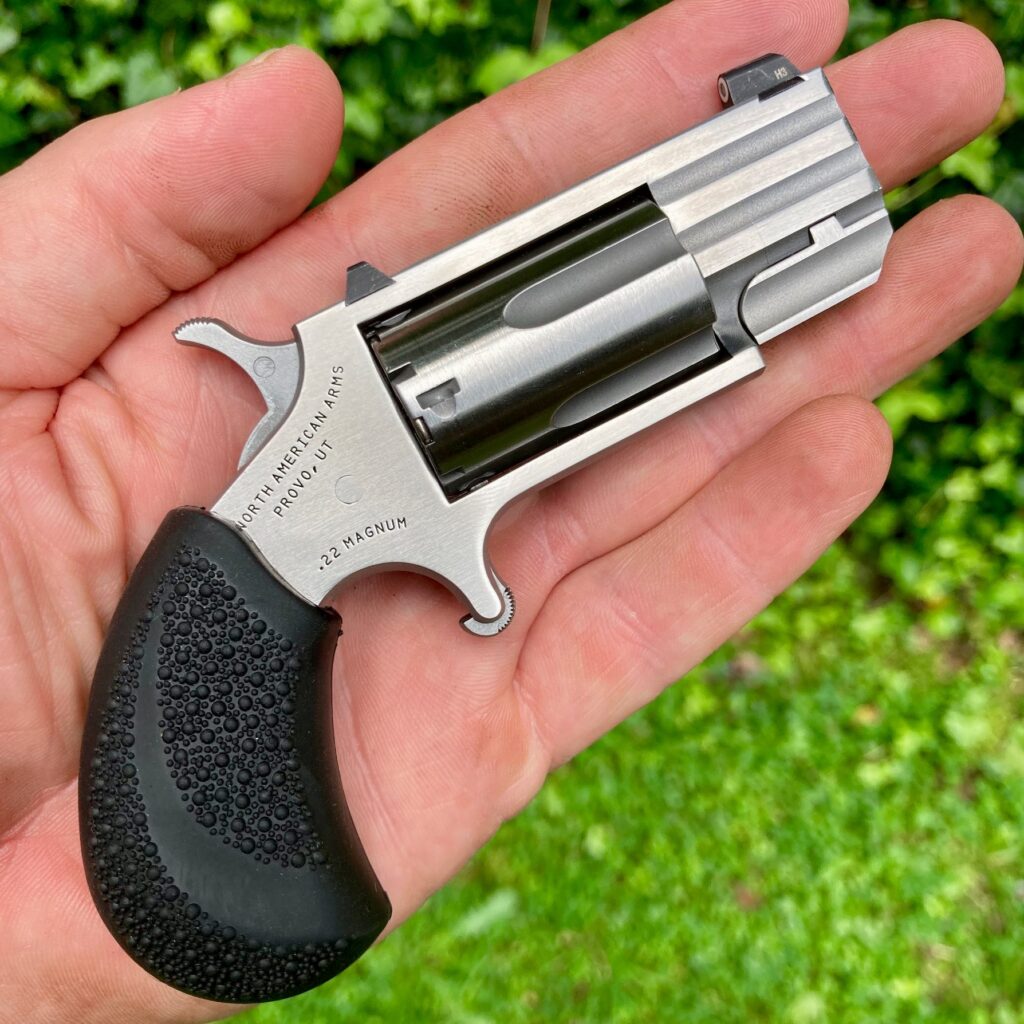
The Pug’s upgraded features begin with its caliber: .22 Winchester Magnum Rimfire (WMR, or just “Magnum” from here on out). The barrel is also square and blocky, and only an inch long. The cylinder pin, which is removed for take-down, is held-in place by a spring-loaded cylinder pin block that sits below the barrel, creating a very chunky look, and no doubt spawned the gun’s moniker.
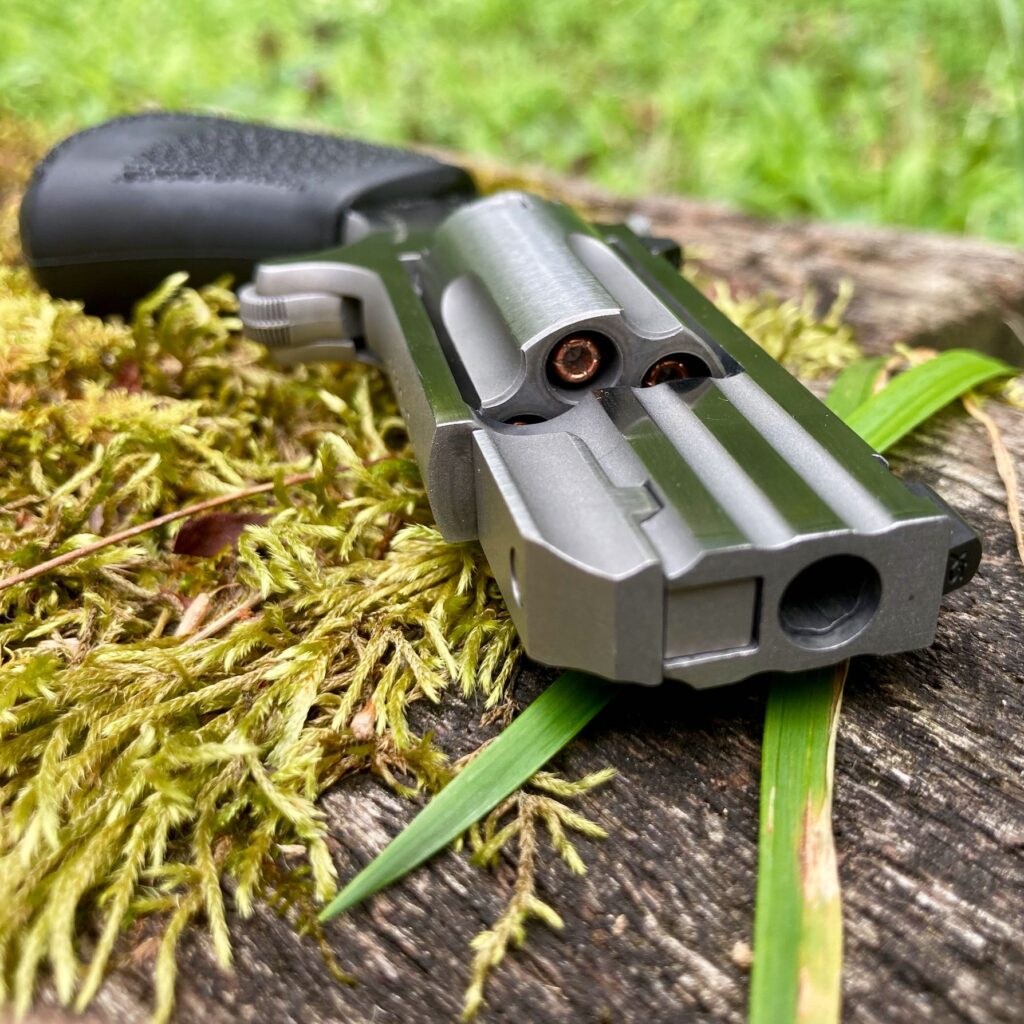
I have never heard anything but good things about the quality of NAA firearms and I was pleasantly unsurprised at the Pug. The machining, fitment, and finish are all top notch. The only complaint I can muster in regards to fit, finish, or aesthetics is the molding circle left on each side of the hammer. Otherwise – and I kid you not – the Pug looks every bit as well manufactured as any production revolver we’ve reviewed here.
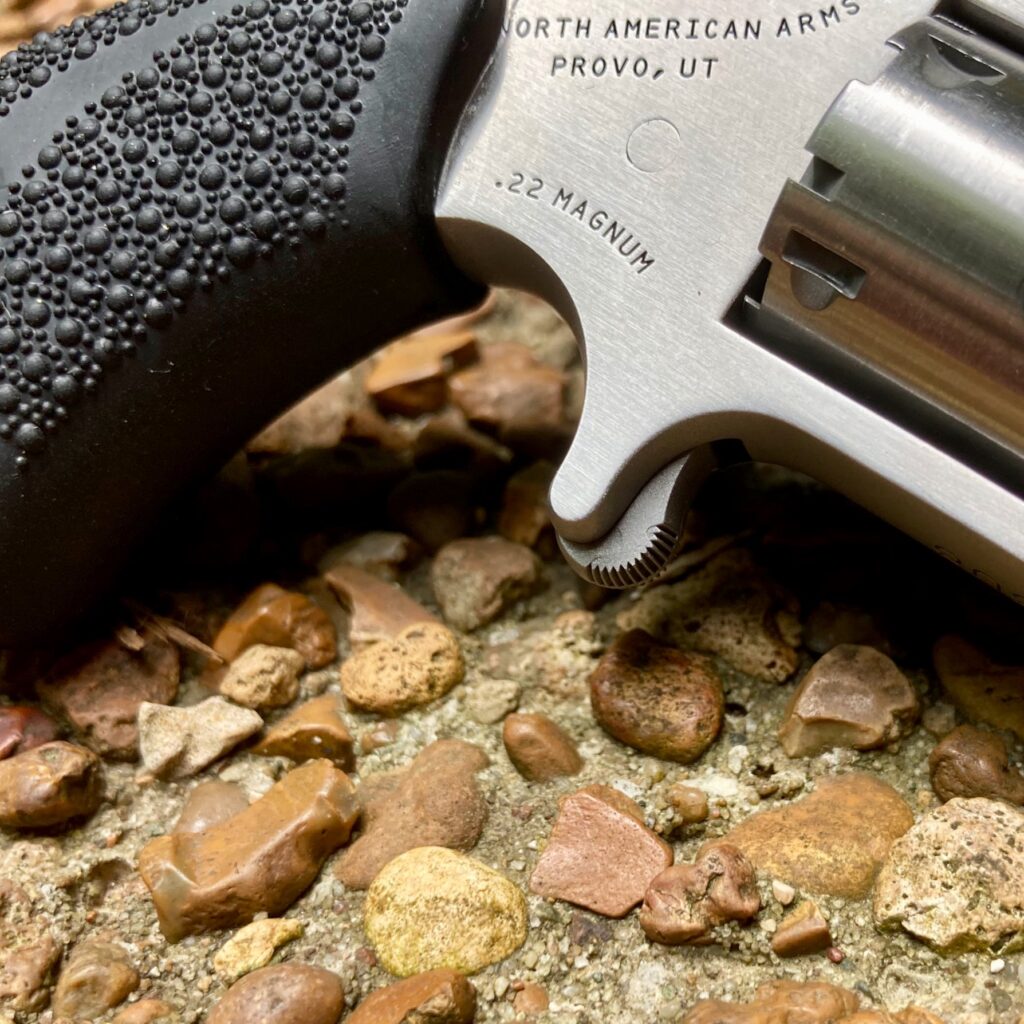
Oh, and one more thing: the way the Pug ships is awesome. I had no idea what to expect but when I opened the box at the gun store I was in for a surprise. The Pug (and presumably all) NAA revolvers ship in a very nice locking, padded, metal box. It’s certainly no bulletproof storage container but it’s a huge step up from the cheap, flimsy, plastic boxes most manufacturers ship their guns in.
Big Sights, Big(ger) Grips
The two other features that made the Pug interesting to me in the first place are the sights and the grips. Many of NAA’s offerings – somewhat understandably – have extremely minimal sights. In fact, most only have a front blade and forego a rear sight altogether. The Pug is a different matter. The Pug is equipped with sights from XS Sighting Systems on both front and rear.
The front sight is available with either a large, white dot or with a tritium insert. Being a fan of sights that self-illuminate, I chose the tritium insert which is still bordered by a broad, very white circle and is quite visible in just about any lighting condition. The rear sight isn’t a traditional notch. Rather, it is a very wide “V” with a white post in the center. To aim one simply superimposes the large circle over the vertical line.
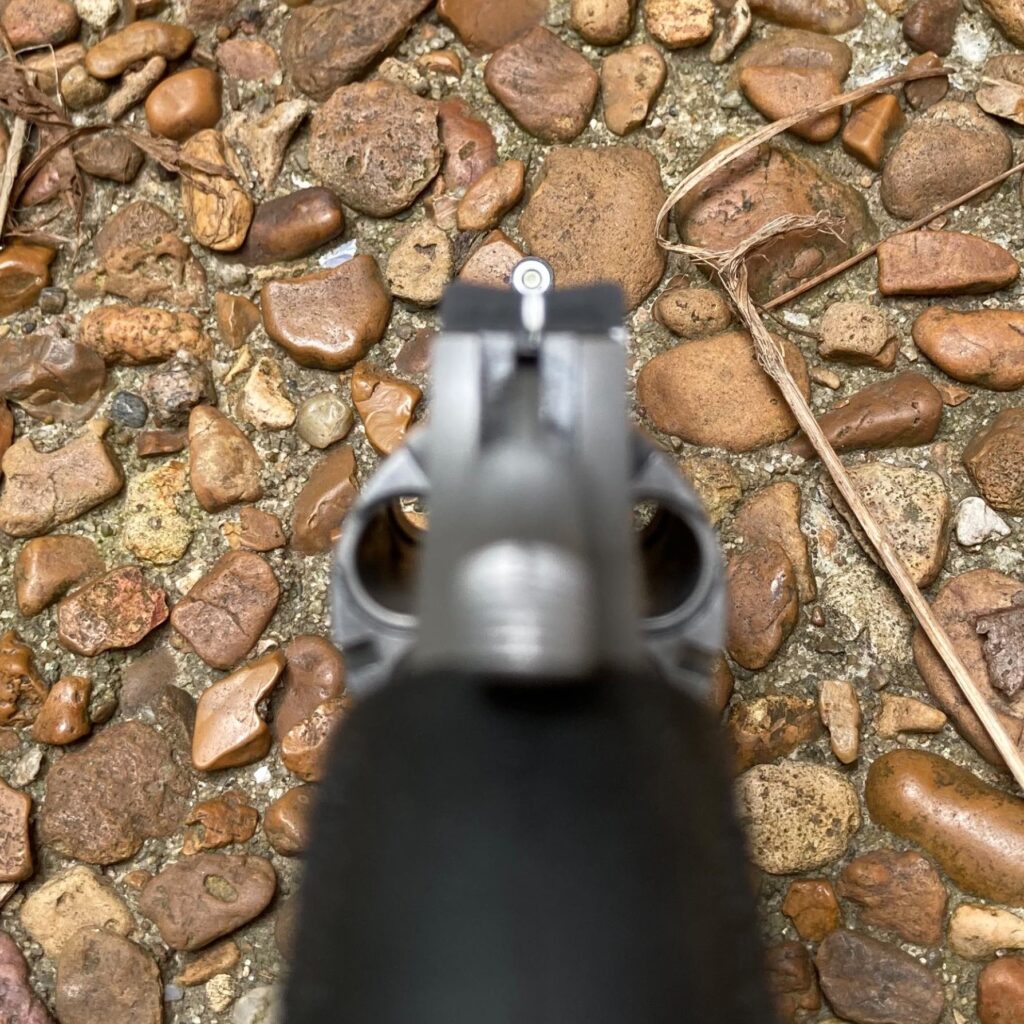
I found the sights quite visible and fast-acquiring, if somewhat imprecise, but I feel these are an ideal arrangement on such a firearm. Both front and rear are dovetailed in should one choose to replace them, or drift them to refine a point of impact.
Most NAA revolvers are appointed with minimalist rosewood grip panels. The rosewood is lovely, and slick, and small. Slick and small make a potentially great combination in one’s pocket, though less so in the hand. The NAA Pug is quipped with a grip that meant to be a bit more comfortable in the hand and on the range.
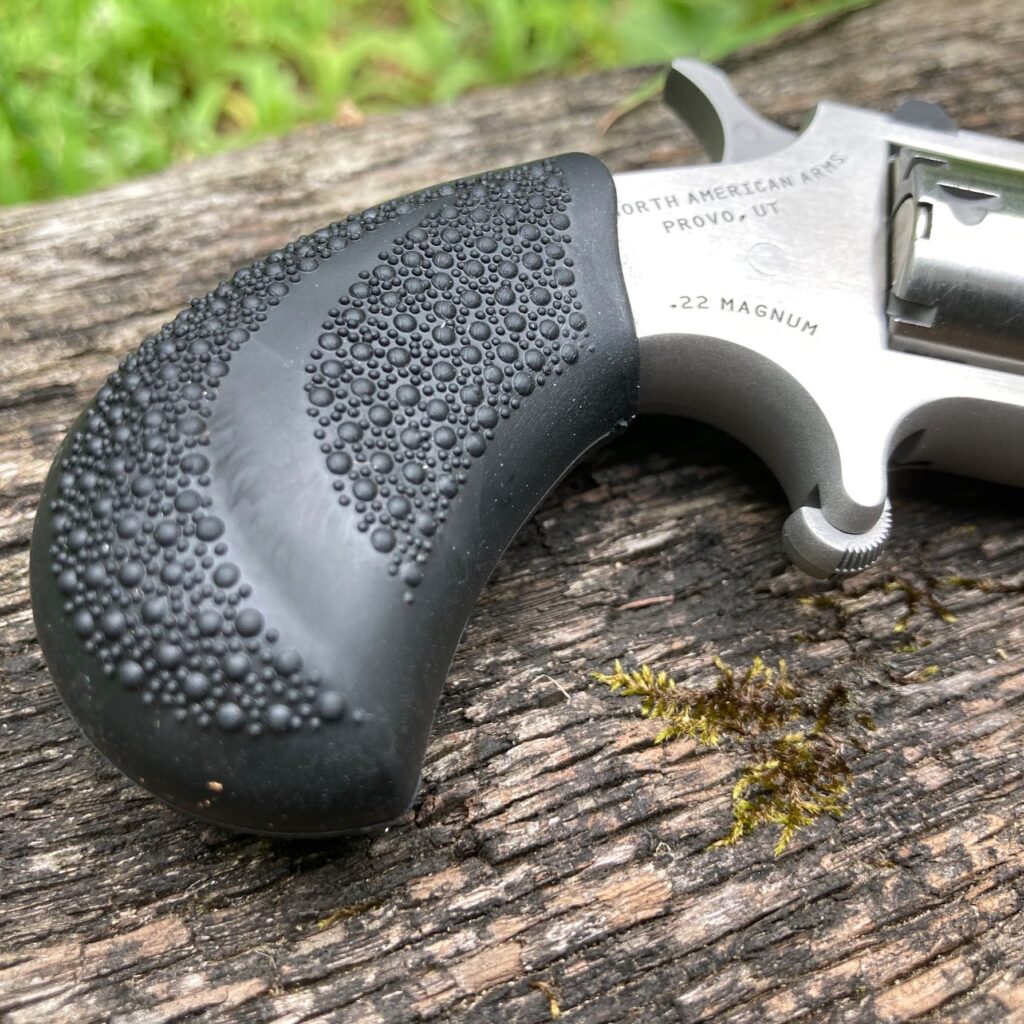
The oversized, soft, pebbled grip is really very comfortable – at least to the small amount of flesh with which you can surround it. More importantly it is grippy. The .22 Magnum bullets fired from this little gun don’t produce a ton of recoil, but they do drive the gun enough to disrupt one’s grasp. The Pug’s larger grips definitely seem to anchor it a bit fairly solidly. And…that’s about it.
Loading & Unloading The Pug
Operations of the NAA Pug are a bit different than most revolvers. Loading and unloading the Pug involves removing the entire cylinder. This precludes any speedy reloads, but if the NAA is your go-to, primary sidearm, you should be seeking something a little more capable. To remove the cylinder, pull down on the cylinder pin block and rotate it 90-degrees.

Next, pull it straight out the end of the gun. I found that this can take just a little bit of doing if you’re shooting the gun a lot. After four or five cylinders the combination of carbon, unburned powder, and heat can make the cylinder pin want to stay in there….and be hesitant about going back in.
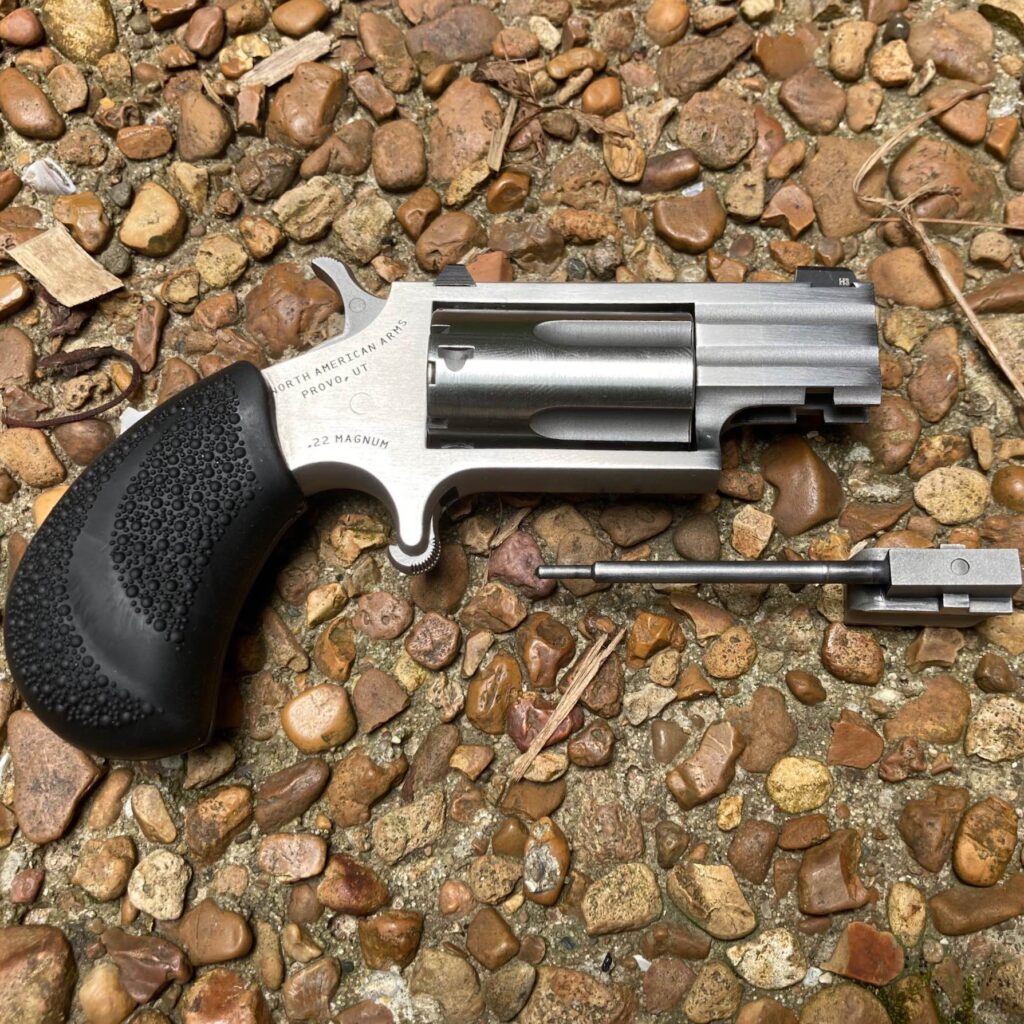
Once the cylinder pin is out of the gun pull back slightly on the hammer (yes, it does have half-cock notch) and rotate the cylinder out the right side of the frame. With the cylinder removed you can insert rounds into it. If need be, you can use the cylinder pin to knock empties loose from their chambers.
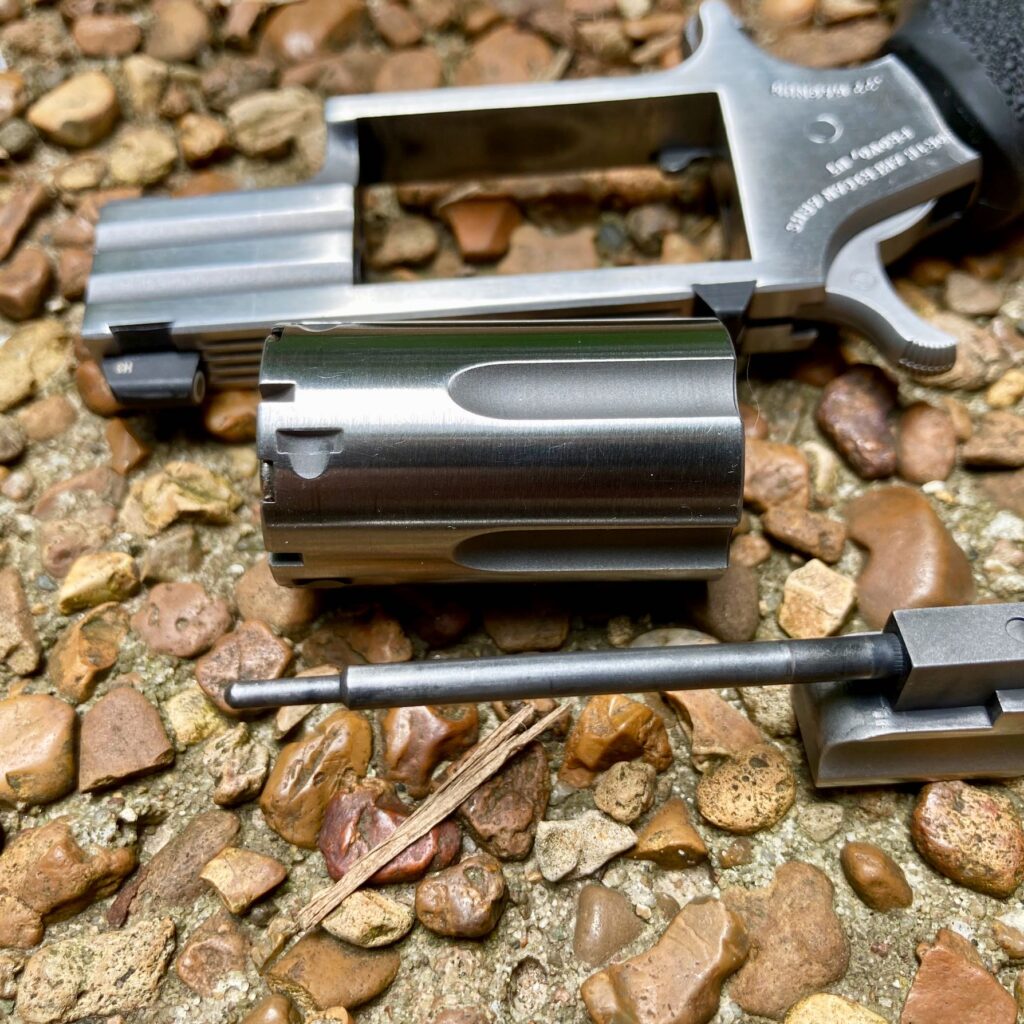
Putting the Pug back together is basically a reverse of that operation. I will admit that it can get a little tricky. Even after a couple dozen cylinders I still had some minor issues getting the cylinder back in place. This dampened my enthusiasm for shooting a whole bunch of ammo through this revolver, though I doubt more than a box or two of ammo is ever fired through most of these revolvers.

Of note, NAA offers a Sidewinder and a Ranger model, both of which should be faster and easier to load and unload. The Sidewinder has a swing-out cylinder, and the Ranger is a break-top design. Unfortunately both lack the feature that makes the Pug so attractive to me: the sights.
Shooting The Pug
I’m not going to lie – I had no idea what firing a .22 Magnum out of such a tiny platform would feel like. It wasn’t bad at all, and dare I say, even a little fun? This revolver is somewhat lively but it is not uncomfortable in the least.
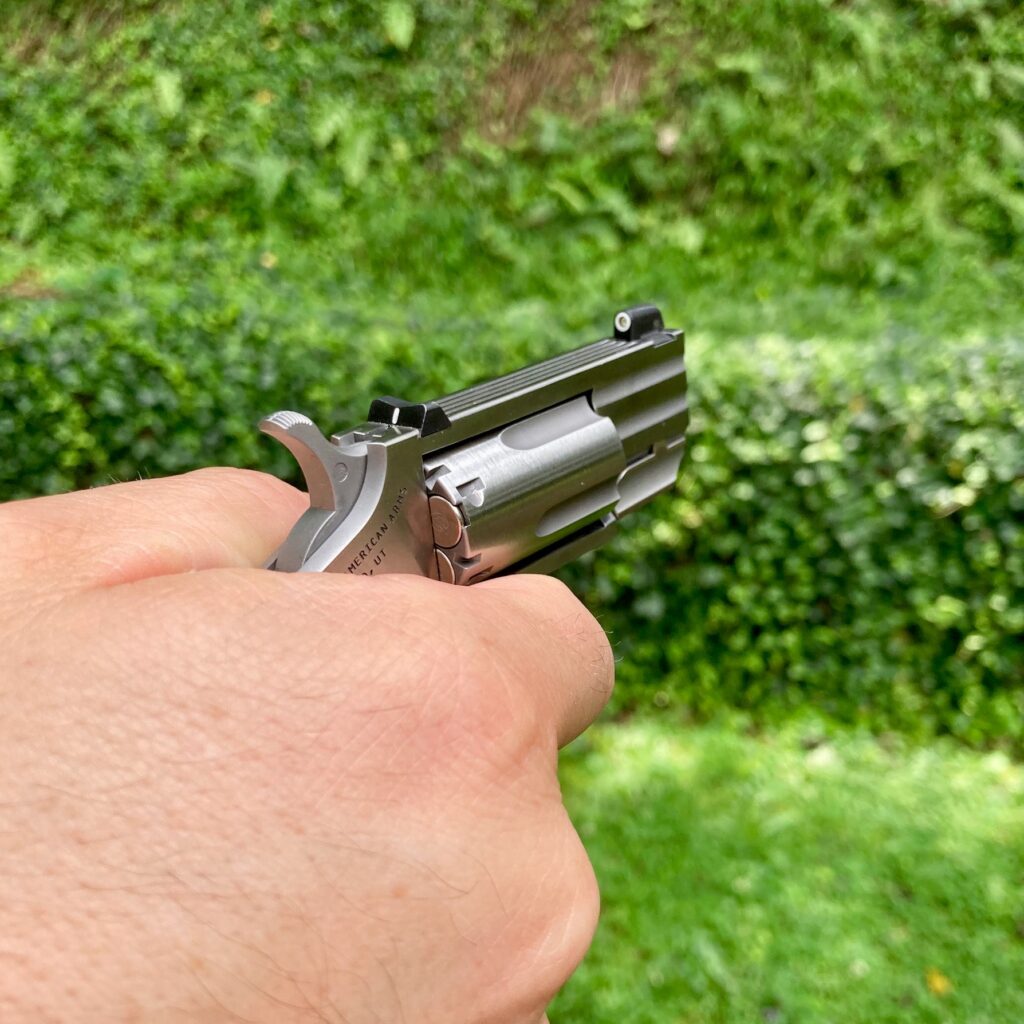
Because of its extremely small size, finding an effective grip can be difficult, however. I found that I wanted to get way, way too high up on the gun, and I had to learn to accept what feels like a marginal grasp. Another problem with grasping the gun correctly is being able to pull the trigger.
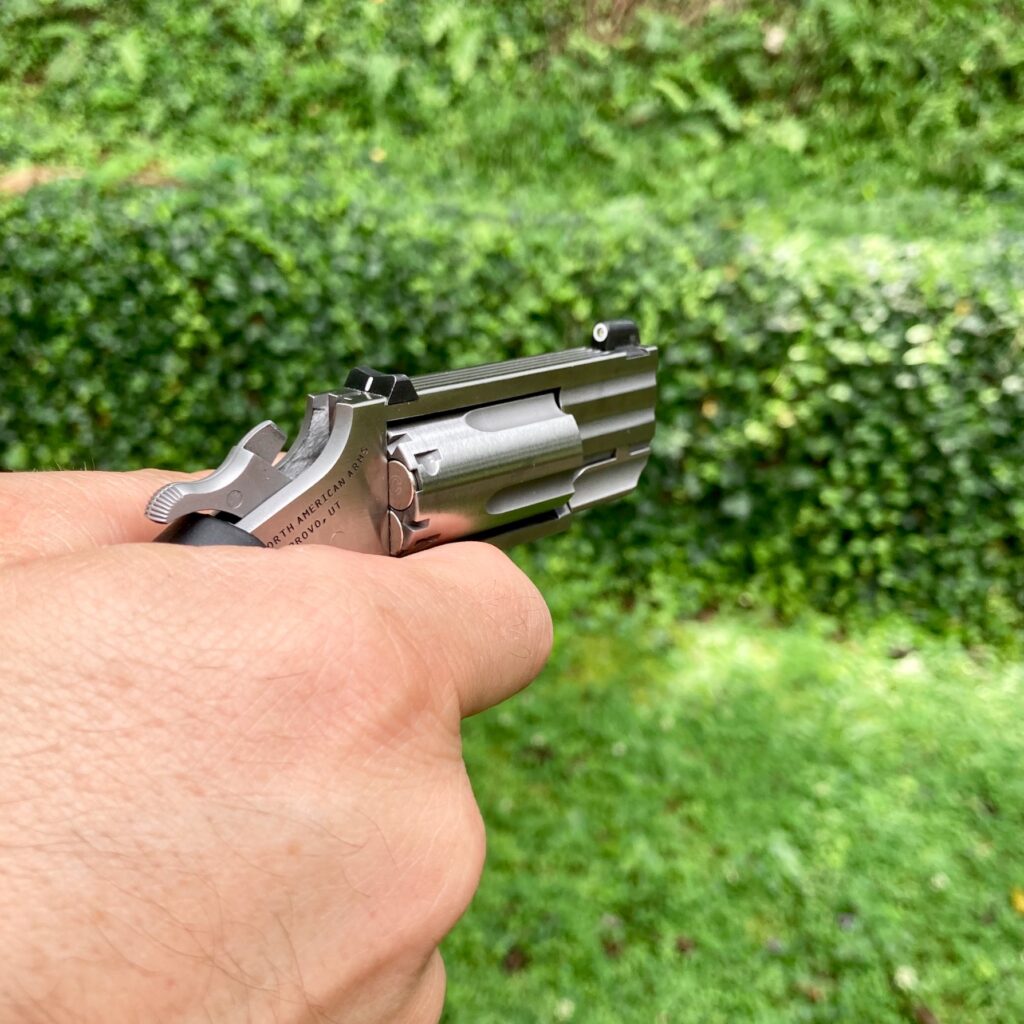
That sounds funny…but the trigger is fairly heavy and there isn’t a ton of travel – the right portion of your finger has to land in almost exactly the right spot. I found that with the gun too deep in the hand, the second knuckle – or even the third phalange – was over the trigger and unable to bend appropriately to pull it.
Accuracy
Accuracy was actually not as bad as I predicted. The group below was fired at three yards, firing five rounds at a time as fast as I could manage accurately. At that distance with a lollipop sight picture and the front sight covering the head I was able to keep all shots in a fist-sized group. Honestly, that’s perfectly adequate accuracy at that distance, and for the intended purpose of this gun. As the range started to extend…well, things didn’t get as bad as I expected.
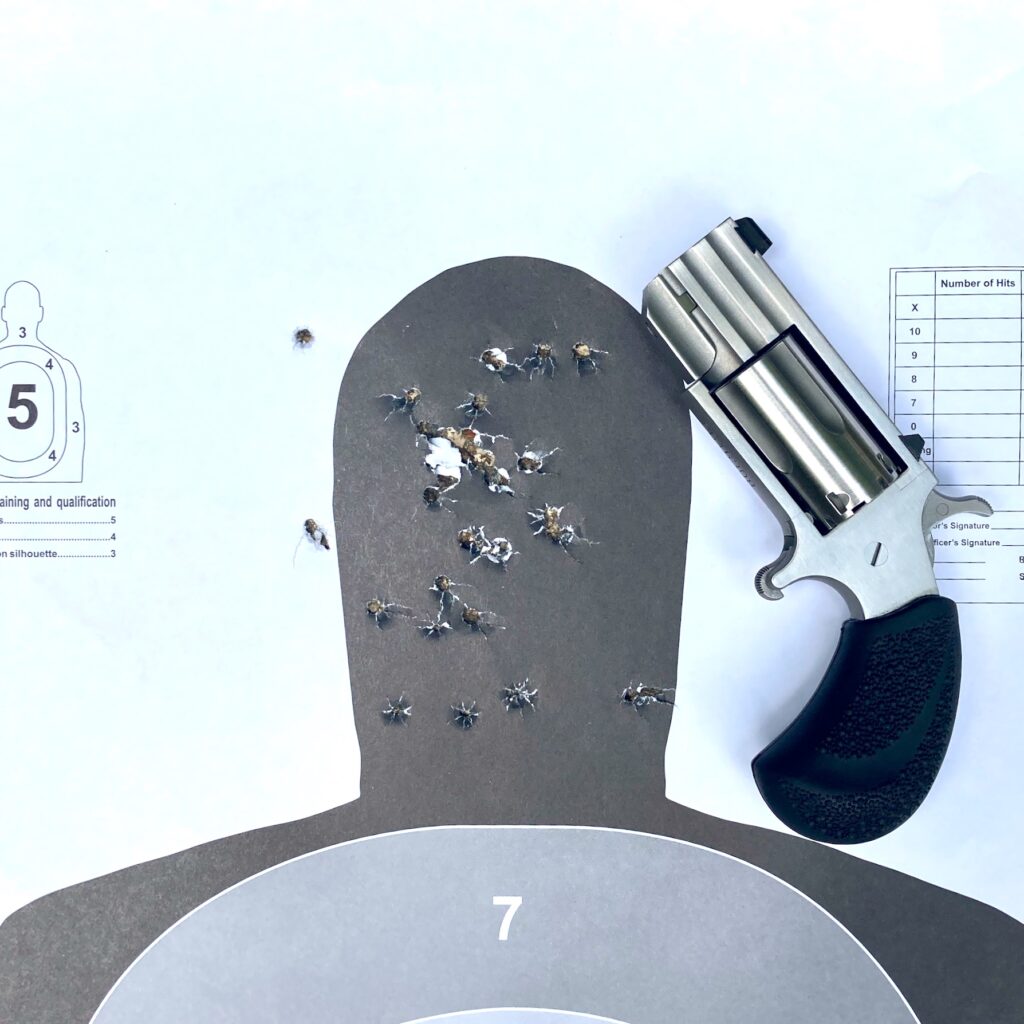
I fired groups at 5, 7, and 10 yards, in my backyard. Honestly, I’m really surprised. Obviously with the extremely coarse sights, heavy trigger, and miniscule grip I wasn’t expecting a whole lot. What I got wasn’t bad.
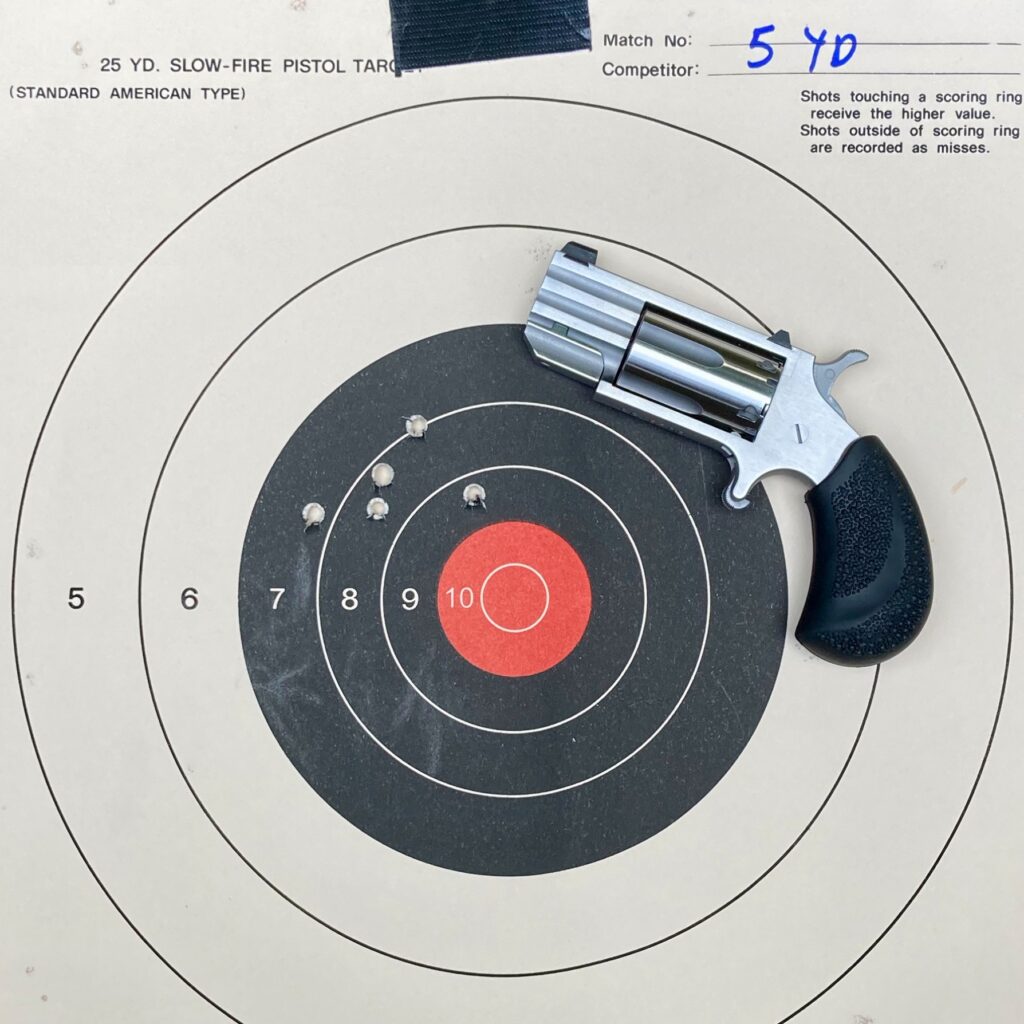
The seven yard group just expanded, moved slightly higher, and slight more to the left. I’m not sure if this was technique on my part, but the trend continued.
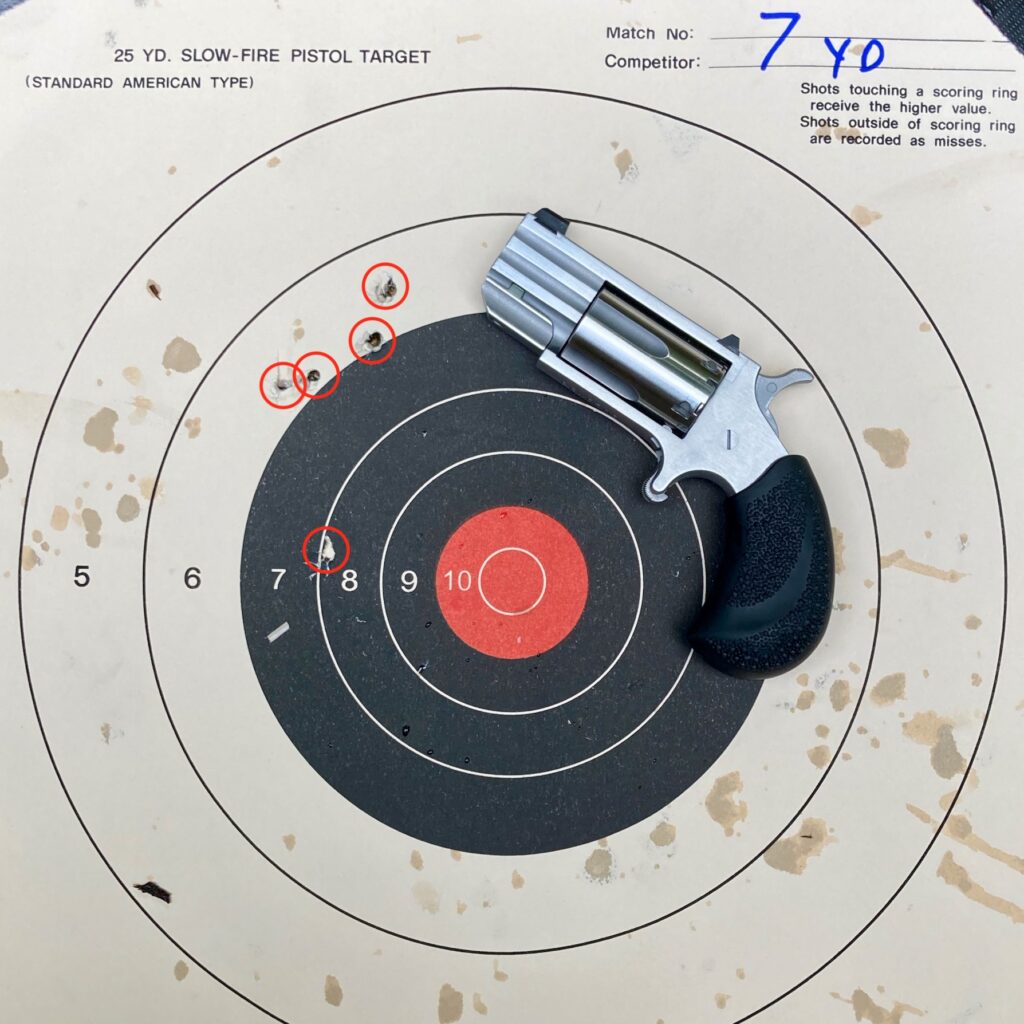
The ten yard group was just more of the same – a respectable group, but still tracking higher and further out to the left.
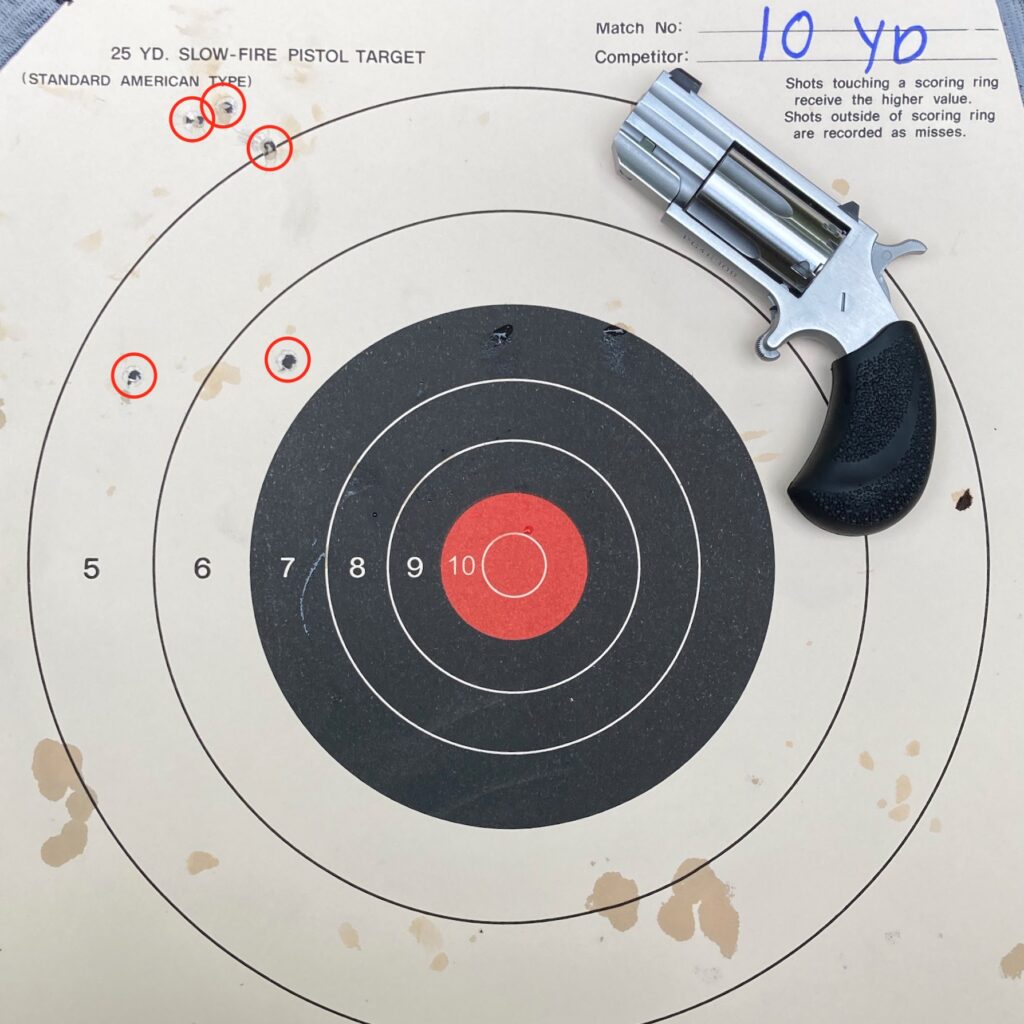
All of these groups were fired with bulk Federal 50-grain JHPs. Since I may have a use for this gun one day I will probably try to find a premium load that hits closer to point-of-aim, like the Gold Dot load. Even with the cheap Federal load and knowing my hold, I’d be comfortable taking a shot at seven yards, and at 10 if I really knew my hold.
Reliability
I fired several different brands of ammunition through the Pug. They included loads from CCI/Speer (the Maxi-Mag and Gold Dot, respectively, and both in 40-grains), two loads from Hornady (the 30-grain V-Max and 45-grain Critical Defense), one from Winchester (the 40-grain PDX-1), and one from Federal (the aforementioned 50-grain bulk ammo.

In total I fired 210 rounds I experienced one, single malfunction and it was with Winchester load. This was clearly an ammo problem – NOT a gun problem. The rim was clearly dented. I reloaded the round so the firing pin would strike in a different spot, albeit with the same result. Every other round went “BANG” on the first strike. I can’t be mad at that kind of performance at all.
Carrying the Pug
As you have doubtlessly noticed, the Pug is a single-action revolver. This means that the hammer must be manually cocked before the gun can be fired. This makes it an incredibly safe firearm to carry; there is very, very minimal risk of it going off so long as you are carrying it in the correct condition. And what is the correct condition?
Like older SA revolvers, the hammer of the Pug (and all NAA revolvers) can rest directly on the rim (in this case the primer) of a cartridge. This creates a problem if the gun is dropped or the hammer suffers a blow significant enough to ignite the primer: in short, the gun may fire. To remedy this NAA has cut notches between each chamber in the cylinder. To prepare for carry you ensure that the firing pin is resting in one of these notches.
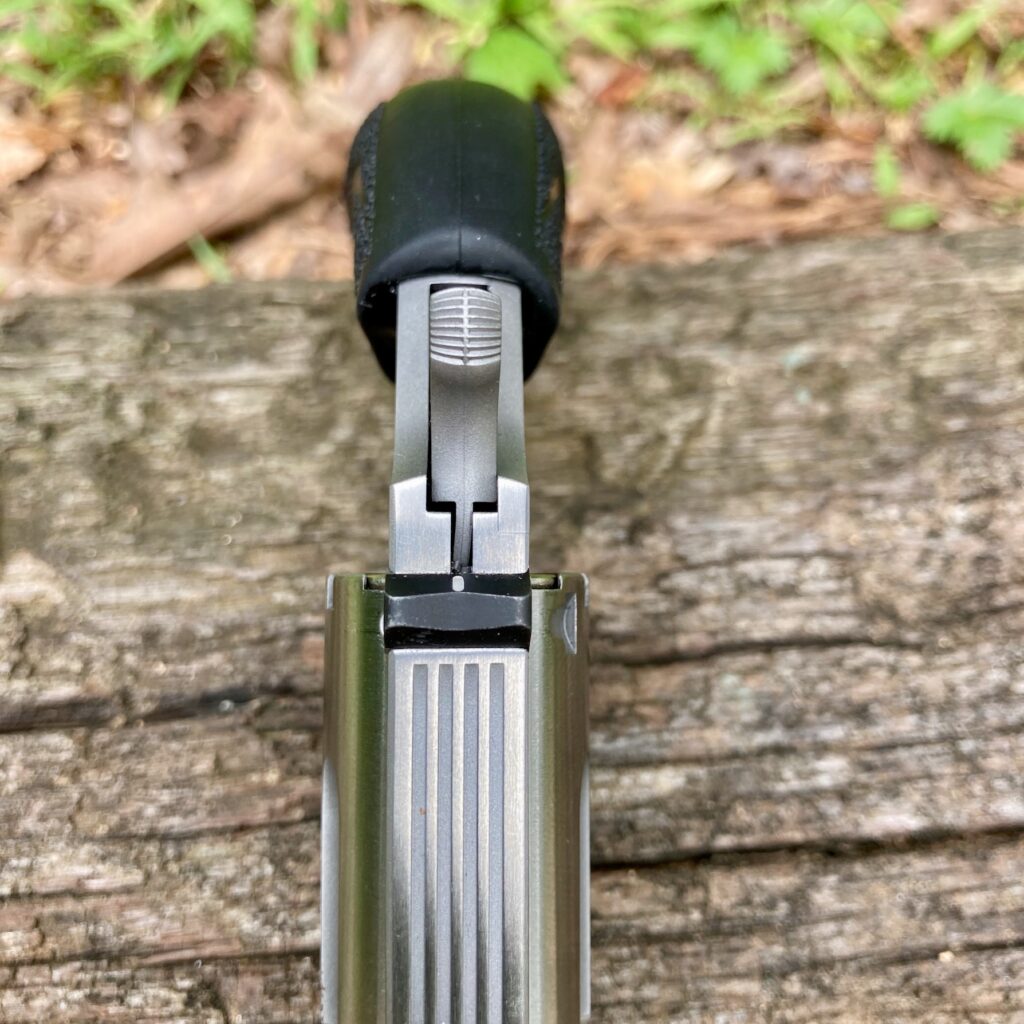
The procedure to do so is described in the Pug’s owner’s manual and I’m not going to repeat it here, lest this turn into an article about single-action safety. If you have one of these revolvers and don’t know how to do this I strongly recommend consulting your owner’s manual. I you’ve lost it, digital copies are available on NAA’s website. For those of you who don’t own one, the procedure is not that difficult, though you will want to do it carefully and with the gun pointed in a safe direction.
I didn’t spend any time at all carrying the NAA Pug, though I certainly don’t rule it out in the future. Though I didn’t get a holster in time for a review, plenty of holsters exist for the Pug. Most of these are pocket holsters, like the Crossbreed pocket holster for which I have high hopes, and a DeSantis holster directly from NAA. Some more esoteric designs are out there, too, like Lost River’s Neck Holster, which I’m also excited to see show up in the mail. Which brings me to the role of the NAA Pug.
The Role of the NAA Pug
I worry that writing this review, which is largely favorable, will be seen as an endorsement of the mini-revolver as a viable, primary carry gun. In unequivocal terms: I do not believe it is and I don’t recommend it. I largely agree with Chris Baker’s conclusion here – it’s under-powered, difficult to shoot accurately, hard to retrieve quickly, and it’s single action. I think it’s a fine gun, but it has a lot of strikes against it for defensive use.
So what the heck is the role of the NAA Pug? I think it enjoys a couple niche roles. First, aside from the tedium of loading and unloading, it’s an enjoyable little revolver to shoot! It fits into that novelty category of things that are just fun to enjoy for their own sake. Second, it truly is an beautifully made firearm, and again, that has its own value. Next, it probably makes nephews wonder a little bit more just what the heck ol’ Uncle Justin is all about!
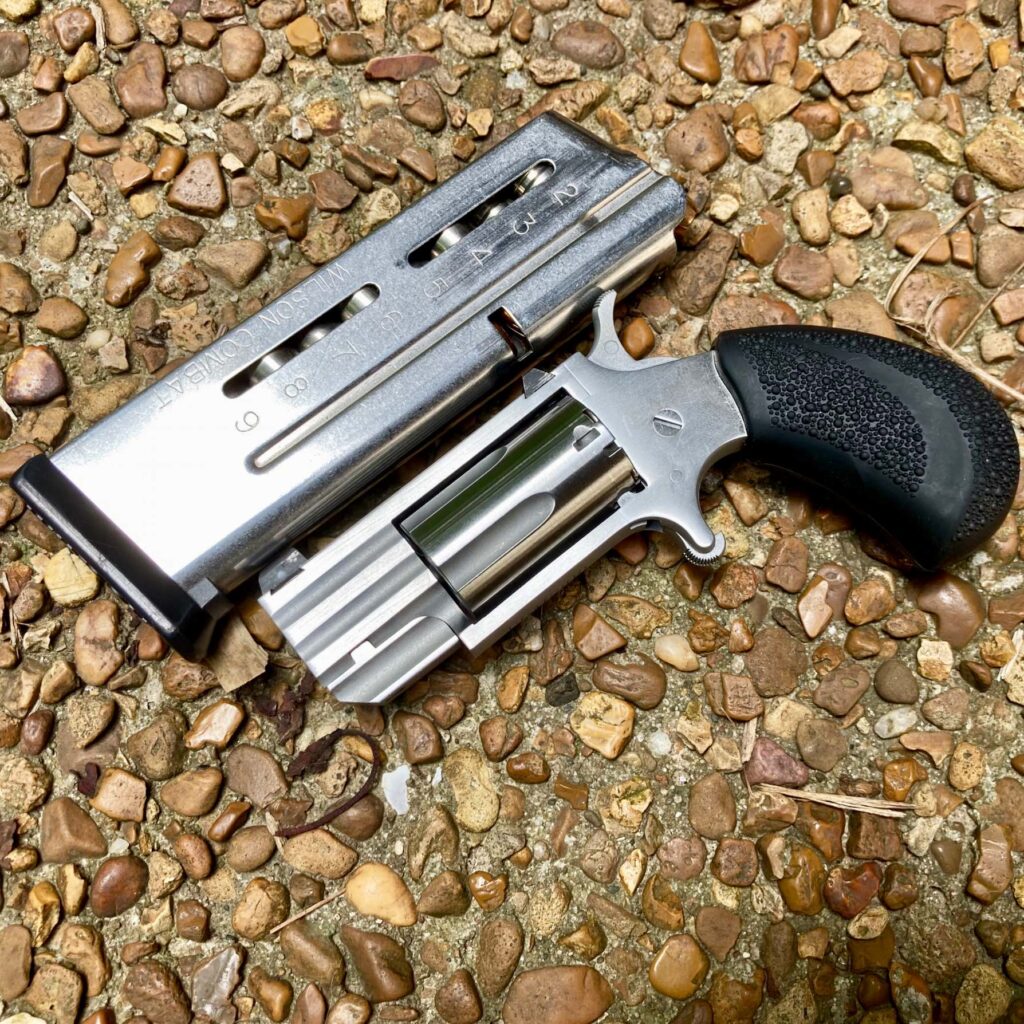
All of those are enough reasons to own a NAA Pug, but my utilitarian mind won’t quite let it go there. I have to justify guns (if only to myself) as filling some perceived need. And I think I’ve found the appropriate use-case for the Pug: it is the crème de la crème of super-deep carry, hideout guns.
I can’t imagine I’ll ever need to, but it’s nice to know that if I had to conceal a gun in a Speedo, I have a workable option for that. More realistically (because I doubt you’ll ever catch me in a Speedo), this may be a gun I can take into some places where carry is discouraged. Though I believe in 99.99% of circumstances you can safely conceal something bigger, an option like the Pug is nice to have for those (admittedly few and far between) situations where you must absolutely stay concealed.
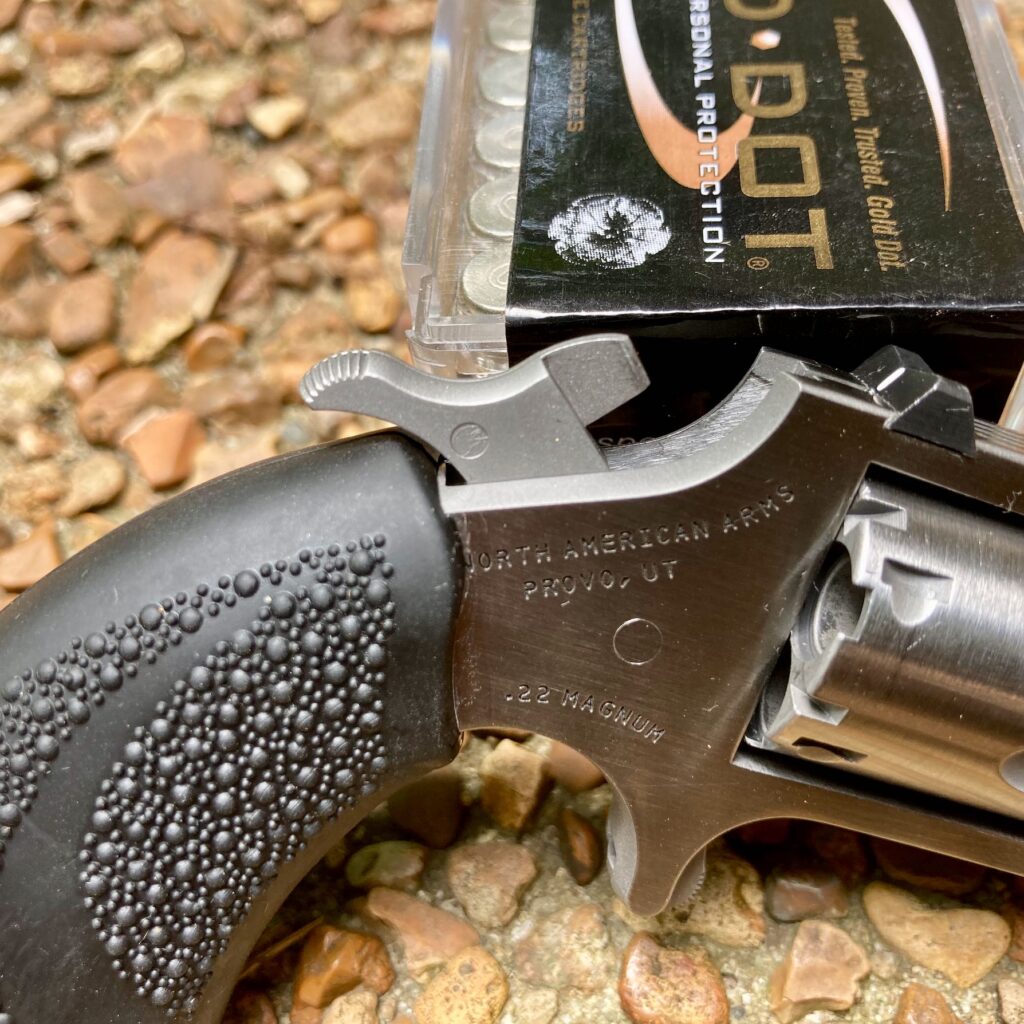
And it’s not just the size that is the benefit here. The single action makes it safe enough to carry in ways that would give me heartburn with just about any other gun. The single action is also probably fairly difficult to foul relative to tiny autos, too.
Other than that, I think the NAA Pug is solidly in third-gun or, at very best, backup gun territory. Among it’s other faults the single-action mini revolver is simply too slow to deploy in self defense. I’m not discouraging you from owning one, but consider its use-case carefully.
The Bottom Line
While not ideally suited to primary carry as a self-defense firearm, I was still able to find a great deal of merit in the NAA Pug. It is quite a lot of fun to shoot and again, a thing of beauty; personally, I think it’s the best of the bunch. I will likely be back with a follow-up on this interesting little revolver soon – as soon as some holsters get here, and once I have a chance to chronograph a few loads, so stay tuned!
In the meantime checkout NAA’s full line of mini-revolvers and – if you already own one – replacement parts and accessories.

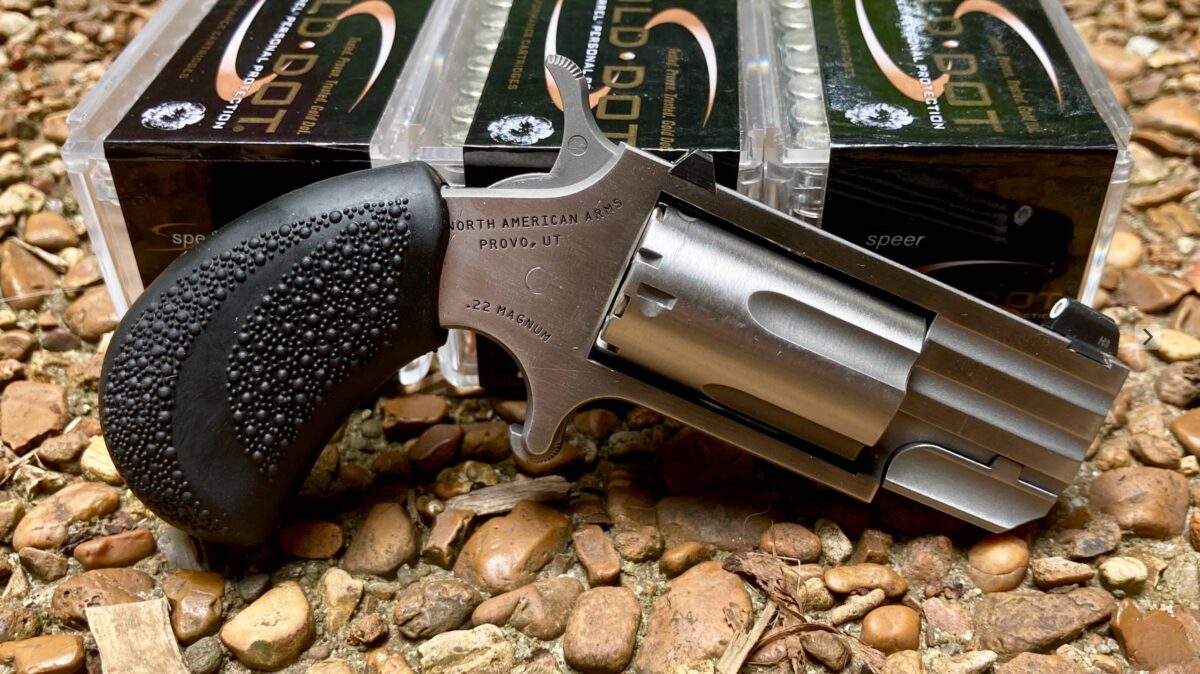
Excellent review!
I had a torrid affair with NAA’s line of chunky models, the Pug, Black Widow, and Mini-Master. Some thoughts:
https://www.thetruthaboutguns.com/north-american-arms-mini-revolver-roundup/
I kept the Black Widow and sold the other two. The BW offered the best balance of ballistics (as anemic as they are), handling, and comfort of carry. If NAA offered a 2.5-3” barreled model, XS sights, and a threaded barrel, I’d buy a half dozen.
Just in case someone else makes the same mistake I started too, the image right below Justin’s comment about the molding mark on the hammer is not intended to demonstrate that issue. The round “mark” seen in that picture is the end of the hammer pivot screw. The molding mark can be seen on the hammer itself in the very first image of the article (or any other image that shows the side of the hammer).
Interesting toy I guess. I had one of these in 22 LR, as well as a High Standard Double Derringer in 22 Magnum, back in the day. To be useful a 22 rimfire needs to be accurate and quick to use. These were neither and went down the road without regret.
I’m surprised to hear it’s a quality weapon! Cool!
I own a NAA In 22lr that I purchased from an auction site for a great price.
It has the smooth rosewood gripsIt’s a blast to shoot and is quite possible one of my favorite guns.
I sometimes carry it in a neck type Clamshell holster similar to what you have named above but find that it swings around and gets in the way.
It may not be the best primary carry but does great in a pinch.
Justin, you’re spot on with the observation that this NAA is best as a 3rd Gun – behind a S&W 642, behind a Glock 19 (or S&W M66). It will hide in copious places that might otherwise be searched, and in the most dire extreme, makes for an excellent Nase Waffe (nose weapon).
One of my associates still rides motors off the clock, and when leathered up, he carries one of these affixed to his riding boot as backup toa S&W 640 and the required 9m/m shell chucker. Even dressed like a metro slouch (which I specialize in) I can envision four places right now where I could stash one.
I have one in .22LR with an integral clip holster/grip. I use it when mowing the lawn in shorts. It’s light enough that my elastic waistband won’t sag. Other than a novelty, that’s about the only niche I can see. Thanks for the review!
Took a 2200 mile round trip on my trike from N.C. to “points out west”. My route and stops classified. The only firearm I carried was a NAA 22 magnum loaded with gold dots. That along with pepper gel and an emerson folder rounded out my self defense tools.I know I know- the combat shooting “experts” ( who’ve never been in combat) will tell me I should be dead. Happy to report I made it out and back alive. Guess Im luckey? Ill repeat the trip in October and see if I can prove them right.
I’m old enough to have carried an S&W Model 10 on duty. My Smith 340 is the one gun I carry daily with confidence.
Back in the day these little 22 revolvers were called “Onion Field” insurance. Google will help you sort that out.
My 340 is as small as I plan to go!
Thanks for the review.
When I worked at the gun store, we had a cab driver come in who carried a NAA .22LR in his shirt pocket, and actually believed he was ready to fend off the evil hordes. I tried my best Gun Shop Guru moves on him, but he refused to be convinced. Carried it in his shirt pocket, and got offended when I asked if it ever fell out when he bent over to pick up something. Didn’t see him for a while; turned out he was coming in when I wasn’t there, because he didn’t like my attitude.
We own the plain jane .22lr model…the gun is reliable, sturdy, extremely concealable…it is also difficult to shoot accurately, uses a small bullet, and reloads ain’t happening…constant practice is required, which is affordable…we rarely carry it, and think of it as a derringer, to be pulled at last moment with surprise…an incredibly tiny niche, but who knows these days…
Old article but I just saw it now. These guns have to be handled a little differently than we are used to if you want to get the most out of them. The correct way to grasp the gun is to hold the stocks with one hand (a fist around the grip) and then grasp your hand with your other hand. That second hand is the one that cocks and fires the gun. The first hand acts like a bigger set of stocks for you.
This doesn’t change the actual utility of the gun, but it does make it much faster and easier to shoot.
In Kansas we fortunately have concealed carry and open carry without a license. I was an open carry guy, but even under my shirt it was noticable and l I kept getting ugly looks at high school games and even at Walmart. So I put my .380 aside and decided to carry my Pug holstered on my belt under my shirt. Truth is muzzle energy is close. Anyway I don’t get those ugly looks anymore and still feel safe having some defense other than none at all.
Glad to hear you’re no longer open carrying, Donn. Too many tactical disadvantages there.
CCI maxi-mag jacketed hollow p0int 40 grain is the best for stopping power.
Anyone who uses the term “stopping power” when talking about handguns of any caliber, is in need of remedial defensive gun use training. Moreover, energy is irrelevant for self-defense in handgun calibers. In sub ~2400 fps projectiles, the physiological damage is done by the projectile cutting and tearing either the circulatory or nervous systems. Anything other than that is a psychological stop, not physiological.
Some gun is better than no gun. I have one of the PUGs. (Stands for Perfect Undercover Gun) It’s my summer time shorts gun. I don’t worry about my pants sagging. And with the right holster it presents pretty fast. I carry it on duty under my vest loaded with Critical Defense rounds. It’s no Glock but it does have a place in my carry collection.
Nothing wrong with that, Larry. Be safe out there!
I am a retired city police officer I started in 1969 I had a 22 lr NAA little revolver that I carried under my police duty belt for years in a holster I made as a last resort gun I called it a ear, nose or throat gun .if I have to explain the ear nose throat==== up close in tight LAST RESORT when I retired I called NAA got a folding clip holster for it an passed it down to my Grandson that was working at a detention center here in county I never had the occasion to have to use the little belt gun. there was no doubt in my mind that with the correct placement of cci ammo what the effect would be,
Charles, thanks for sharing your experience with the mini revolvers. I’m glad you made it to the finish line safely and thank you for your many years of service. I hope that revolver keeps your grandson just as safe.
I have the Pug
Love it. A critical defence round trumps a fist any day